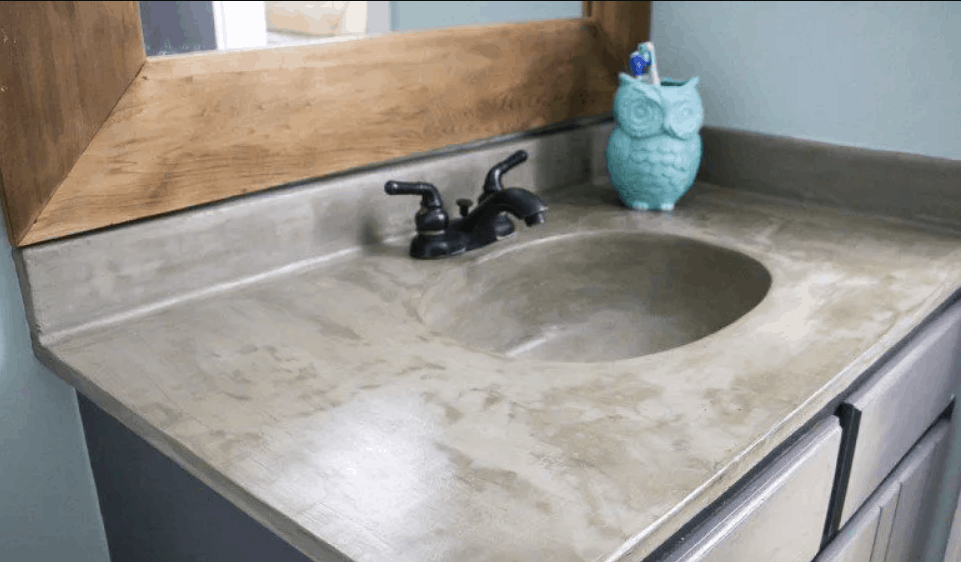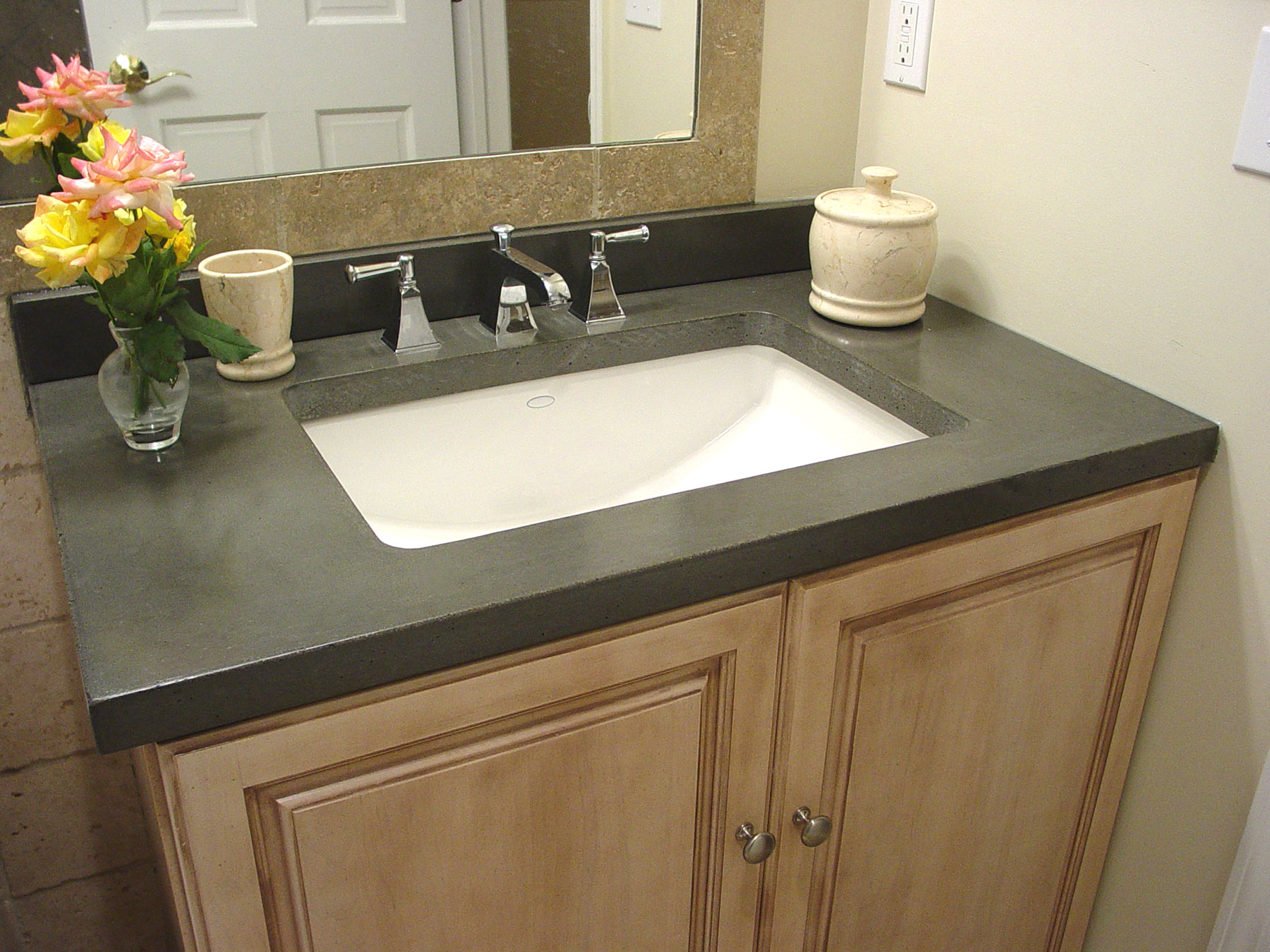In this comprehensive guide, we’ll walk you through the process of painting your bathroom vanity top to refresh the look of your space and give it a new lease on life. Whether you’re tired of the outdated color or simply looking for a budget-friendly way to upgrade your bathroom, painting your vanity top can be a rewarding DIY project. With the right tools, materials, and techniques, you can achieve professional-looking results that will breathe new life into your bathroom.
Painting your bathroom vanity top is a cost-effective way to transform the look of your bathroom without the need for a complete renovation. With a little bit of time and effort, you can give your vanity a fresh, updated appearance that will enhance the overall aesthetic of your space. In this guide, we’ll provide you with step-by-step instructions on how to paint your bathroom vanity top like a pro.
Materials and Tools Needed

Before getting started, it’s important to gather all the necessary materials and tools. Here’s what you’ll need:
- Painter’s tape: To protect surrounding surfaces from paint.
- Sandpaper: For prepping the surface.
- Primer: To ensure proper adhesion of the paint.
- Paint: Choose a high-quality paint suitable for bathroom surfaces.
- Paintbrushes: Use a combination of brushes for detailed work and larger areas.
- Roller: For applying paint to larger sections of the vanity top.
- Drop cloth: To protect the floor from drips and spills.
- Cleaning supplies: To clean the vanity top before painting.
- Protective gear: Gloves, mask, and goggles to protect yourself from fumes and paint splatter.
Step-by-Step Guide

Step 1: Prepare the Vanity Top
Preparing the vanity top is a crucial step in the painting process, as it ensures that the paint adheres properly and results in a smooth, long-lasting finish. Here’s a deeper explanation of each aspect of this step:
- Remove any hardware: Before you begin painting, it’s essential to remove any knobs, handles, or other hardware attached to the vanity top. This will allow you to paint the surface evenly and reach all areas without obstruction. Use a screwdriver or appropriate tool to carefully unscrew and remove the hardware, keeping track of all pieces to ensure they can be reattached later.
- Clean the surface: Next, thoroughly clean the surface of the vanity top to remove any dirt, grime, or grease that may have accumulated over time. Use a mild cleaner or detergent and warm water to scrub the surface, paying close attention to any areas that may be particularly dirty or stained. Rinse the surface thoroughly with clean water and allow it to dry completely before proceeding to the next step. A clean surface is essential for ensuring proper adhesion of the paint and a smooth finish.
- Sand the surface: Once the vanity top is clean and dry, use fine-grit sandpaper to lightly sand the entire surface. Sanding helps to roughen up the surface slightly, creating a texture that allows the primer and paint to adhere more effectively. Focus on areas that may have a glossy or smooth finish, as these can be more challenging for paint to stick to. Be sure to sand evenly and avoid applying too much pressure, as this can damage the surface. Once you’ve finished sanding, use a clean cloth or tack cloth to remove any dust or debris from the surface before proceeding to the next step.
Step 2: Apply Primer
Applying primer is a crucial step in the process of painting your bathroom vanity top, as it helps to ensure proper adhesion of the paint and creates a smooth, uniform surface for the paint to adhere to. Here’s a deeper explanation of this step:
- Prime the surface: Before applying paint to the vanity top, it’s important to apply a coat of primer. Primer serves several purposes, including sealing the surface, providing a consistent base for the paint, and improving the durability and longevity of the finished paint job. Choose a high-quality primer that is specifically designed for use on bathroom surfaces and is compatible with the type of paint you’ll be using.
- Prepare the primer: Before applying the primer, be sure to stir it thoroughly to ensure that any settling or separation of the components is properly mixed. If the primer is too thick or thin, it may not apply evenly or provide adequate coverage, so it’s important to achieve the proper consistency before starting.
- Apply the primer: Using a paintbrush or roller, apply the primer to the entire surface of the vanity top in thin, even coats. Work methodically, starting from one end of the vanity top and moving to the other, to ensure complete coverage. Be sure to apply the primer evenly and avoid leaving any thick or thin spots, as this can affect the final appearance of the painted surface.
- Allow the primer to dry: Once the primer has been applied, allow it to dry completely before proceeding to the next step. The drying time will vary depending on the type of primer used and environmental factors such as temperature and humidity, so be sure to consult the manufacturer’s instructions for specific guidance. It’s essential to allow the primer to dry fully to ensure proper adhesion and a smooth, professional-looking finish.
Step 3: Paint the Vanity Top
Once the primer has dried thoroughly, it’s time to apply paint to the vanity top. This step is where you’ll add color and personality to your bathroom space. Here’s a deeper explanation of how to paint the vanity top effectively:
- Choose your paint: Selecting the right paint is crucial for achieving the desired look and durability of your vanity top. Opt for a high-quality paint specifically designed for use in bathrooms or high-moisture areas. Consider factors such as color, finish (e.g., satin, semi-gloss), and durability when choosing your paint.
- Prepare the paint: Before applying the paint, stir it thoroughly to ensure that any pigments or additives are evenly distributed throughout the can. If the paint has been sitting for a while, it may have settled, so be sure to mix it well to achieve a consistent color and texture.
- Apply the paint: Using a paintbrush or roller, apply the paint to the vanity top in thin, even coats. Start from one end of the vanity top and work your way to the other, overlapping each stroke slightly to ensure complete coverage. Be careful not to apply too much paint at once, as this can lead to drips, runs, or an uneven finish. Take your time and work methodically to achieve a smooth, professional-looking result.
- Allow the paint to dry: After applying the first coat of paint, allow it to dry completely before applying additional coats. The drying time will vary depending on factors such as the type of paint used, humidity levels, and ventilation in the room. Be sure to follow the manufacturer’s instructions for specific guidance on drying times. Once the first coat is dry, you can apply additional coats as needed to achieve the desired coverage and finish.
- Touch up as needed: After the final coat of paint has dried, inspect the vanity top for any areas that may need touch-ups. Use a small brush or roller to carefully touch up any spots where the paint may be thin or uneven. Pay close attention to edges and corners, as these areas can be more challenging to paint evenly.
Step 4: Finishing Touches
After painting the vanity top, it’s time to add the finishing touches to complete the transformation. Here’s a deeper explanation of this final step:
- Reattach hardware: Once the paint has dried completely, reattach any hardware that was removed from the vanity top before painting. Use a screwdriver or appropriate tool to carefully reattach knobs, handles, and any other hardware, ensuring that they are securely fastened.
- Remove painter’s tape: Carefully remove any painter’s tape that was used to protect surrounding surfaces from paint splatter and spills. Peel the tape away slowly and evenly to avoid damaging the paint or leaving behind any residue.
- Touch up as needed: Inspect the vanity top for any areas that may need touch-ups or additional paint. Use a small brush or roller to carefully touch up any spots where the paint may be thin or uneven, paying close attention to edges and corners.
- Allow time to cure: Give the paint ample time to cure before using the vanity top. This will help ensure that the paint fully adheres to the surface and achieves maximum durability. Follow the manufacturer’s instructions for specific guidance on curing times, and avoid using the vanity top until the paint has fully cured.
- Clean up: Once the painting process is complete, clean up any paint spills or drips and properly dispose of any used paintbrushes, rollers, or other painting supplies. Wipe down any surfaces that may have come into contact with paint to ensure a clean and tidy finish.
- Enjoy your newly painted vanity top: Once the paint has dried and cured completely, step back and admire your handiwork! Your freshly painted vanity top will add a fresh, updated look to your bathroom space and provide years of enjoyment. Take pride in the fact that you were able to transform your bathroom without the need for a costly renovation.
Tips and Tricks

- Choose the right paint: Select a high-quality paint specifically designed for use in bathrooms or high-moisture areas. Look for paint that offers durability, resistance to moisture, and easy cleanability. Consider the color and finish that will best complement your bathroom decor.
- Prepare the surface properly: Proper surface preparation is key to a successful paint job. Clean the vanity top thoroughly to remove any dirt, grime, or grease. Use sandpaper to lightly sand the surface, creating a rough texture that will help the paint adhere better. Be sure to remove any dust or debris before painting.
- Use quality tools: Invest in high-quality brushes, rollers, and other painting supplies to ensure smooth, even application of the paint. Cheap or worn-out brushes and rollers can result in streaks, drips, and an uneven finish. Take care of your tools and clean them properly after each use to prolong their lifespan.
- Protect surrounding surfaces: Use painter’s tape and drop cloths to protect surrounding surfaces from paint splatter and spills. Cover any areas that you don’t want to get paint on, such as walls, floors, and fixtures. Take your time to apply the tape carefully and evenly for clean, crisp edges.
- Ventilate the area: Proper ventilation is important when painting indoors, especially in a small space like a bathroom. Open windows and doors to allow fresh air to circulate and help dissipate paint fumes. Consider using a fan or exhaust fan to improve air circulation and speed up drying times.
- Follow manufacturer’s instructions: Always read and follow the manufacturer’s instructions on the paint and primer labels for best results. Pay attention to recommended drying times, application techniques, and any safety precautions. If you’re unsure about anything, don’t hesitate to reach out to the manufacturer for clarification.
- Take your time: Painting your bathroom vanity top is a project that requires patience and attention to detail. Take your time to properly prepare the surface, apply the paint evenly, and allow each coat to dry completely before proceeding to the next. Rushing through the process can result in mistakes and poor results.
- Inspect and touch up as needed: Once the paint has dried, inspect the vanity top for any areas that may need touch-ups or additional paint. Use a small brush or roller to carefully touch up any spots where the paint may be thin or uneven. Pay close attention to edges, corners, and areas that may be prone to wear and tear.
Conclusion
Painting your bathroom vanity top is a simple yet effective way to update your bathroom and give it a fresh, new look. By following the steps outlined in this guide and using the right materials and tools, you can achieve professional-looking results that will enhance the overall aesthetic of your space. So roll up your sleeves, gather your supplies, and get ready to transform your bathroom vanity top with a fresh coat of paint!

